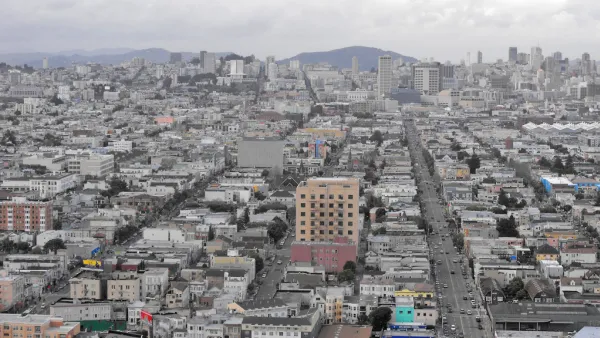The Bay Area is finalizing its plan to comply with state legislation to reduce vehicle emissions from transportation. "Plan Bay Area" has aroused fears of regional government and more, which were expressed at a recent public meeting.
Bill Silverfarb writes on how the plan - written by the Bay Area's two regional planning agencies, the Metropolitan Transportation Commission and the Association of Bay Area Governments to meet state legislation (SB 375: The Sustainable Communities and Climate Protection Act of 2008) was received by some of the 200 attendees at the meeting in Foster City, including Foster City Councilman Art Kiesel.
“They are pushing mixed-use developments at public transit centers. That’s OK. But it is nothing new. It’s New York City revisited,” Kiesel said. “They are trying to push a global plan but then say ‘it’s up to you locals.’ What if I don’t want this?”
Fortunately, Silverfarb also interviewed Egon Terplan, Regional Planning Director of SPUR (San Francisco Planning + Urban Research Association), who analyzed the plan with Ethan Lavine.
Those who oppose the plan do so because of a “fundamental misunderstanding,” he said.
“Land use lies with local governments. The plan gives no power to enforce where housing is built,” Terplan said.
Terplan and Lavine's analysis appear in the SPUR blog on April 29: "What You Need to Know About Plan Bay Area".
Plan Bay Area formally combines two existing regional planning processes, the Regional Transportation Plan (RTP) and the Regional Housing Needs Allocation. The goal is to better link regional transportation planning and funding with a projection for future land use.
The housing allocation process has long been resented by many city councils - and the residents they represent on the affluent San Francisco Peninsula (San Mateo County and northern Santa Clara County). Heretofore, the RTP had been more of a contest of what transportation projects to fund - but it took on more of a land-use focus with SB 375. With land use, housing, and regional planning agencies, Plan Bay Area was sure to be controversial with many at the hearing.
FULL STORY: What is Plan Bay Area?: Region adopting strategy for future growth

Analysis: Cybertruck Fatality Rate Far Exceeds That of Ford Pinto
The Tesla Cybertruck was recalled seven times last year.

National Parks Layoffs Will Cause Communities to Lose Billions
Thousands of essential park workers were laid off this week, just before the busy spring break season.

Retro-silient?: America’s First “Eco-burb,” The Woodlands Turns 50
A master-planned community north of Houston offers lessons on green infrastructure and resilient design, but falls short of its founder’s lofty affordability and walkability goals.

Test News Post 1
This is a summary

Analysis: Cybertruck Fatality Rate Far Exceeds That of Ford Pinto
The Tesla Cybertruck was recalled seven times last year.

Test News Headline 46
Test for the image on the front page.
Urban Design for Planners 1: Software Tools
This six-course series explores essential urban design concepts using open source software and equips planners with the tools they need to participate fully in the urban design process.
Planning for Universal Design
Learn the tools for implementing Universal Design in planning regulations.
EMC Planning Group, Inc.
Planetizen
Planetizen
Mpact (formerly Rail~Volution)
Great Falls Development Authority, Inc.
HUDs Office of Policy Development and Research
NYU Wagner Graduate School of Public Service


























